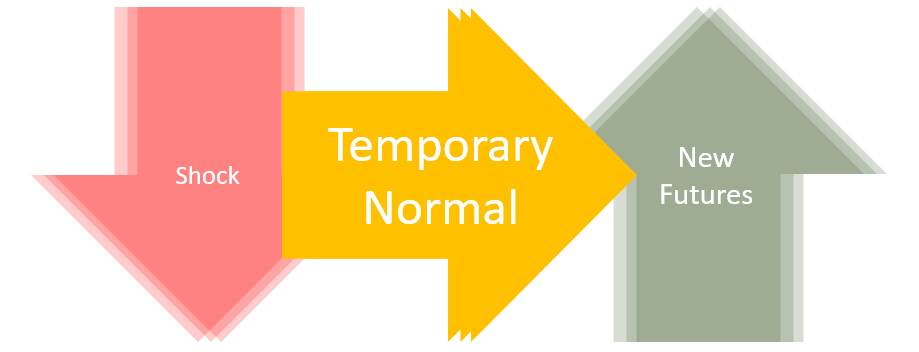
Product Management in Changing Times (Part 2): Temporary Normal
Continued from part 1: The Shock
Managing through a state of temporary normality
Having come through the initial phase and made adjustments for the new world, life becomes a little clearer. However, given that this could last 3, 4, 5 or 6+ months, ambiguity remains and the focus now turns to managing through a state of temporary normality.
Continuing with the themes of people & leadership, ways of working and product strategy, a new pattern is starting to take shape.
People & Leadership
On the people side, remote communication skills and digital etiquette are being polished as more is learnt about how best to engage in conversations and meetings via video calls, chat apps, email and the phone. Although, at times, this can be testing, learning about personal and co-worker preferences and reading useful resources have helped to improve interactions.
Leading the product team has been assisted by:
- Checking in on the team regularly and focusing some of those chats on their well-being (and not work).
- Understanding each team member’s situation and being flexible with expectations and ways of working.
- Increasing the level of delegation and providing the scope to get on and deliver.
- Taking a leaf out of New York Governor Andrew Cuomo’s[i] book and increasing trust through being open, honest and transparent.
Ways of working
With the excitement (or dread) of working from home out the way, a pattern of work has started and includes:
- An agreed flow of work across the team and stakeholders.
- Agreed norms and etiquette for meetings, video calls, messaging, etc.
- Achieving a good level of proficiency with new and existing tools (from video conferencing to VPNs, digital whiteboards, chat tools and cloud-based apps, etc.).
- Access to the right of information at the right time.
- Timely updates and support from the leadership team.
- A work-life balance that includes exercise and regular breaks.
Alternatively, it might be a bit bumpy as you miss the serendipitous water cooler moments and buzz of the office; have too many video calls and are tired of your screen; are working too many hours and never switch off and/or have realised that working from home every day is not for you. If this is the case, hopefully, you’re working through these challenges and have remained positive![ii]
Product strategy
Now you’ve had a chance to breathe you’ve started to gathering customer, product performance, business strategy and external insights to adjusting your product strategy and:
- Address any changes in existing customer behaviour and needs. This may be a Zappos moment – a chance to demonstrate an ability to promptly solve customer problems[iii]. Just like Asda and M&S who introduced volunteer shopping cards that enable volunteers to shop for those in need without receiving cash or card details.
- Explore new customer needs and how to meet them. For those fortunate enough to be acquiring new customers, this is an opportunity to develop their loyalty. Similarly, with a changed direction or having introduced new products for new customers, this will be a period of delving into customers’ needs as they engage or you try to get them to engage.
- Tackle competitors’ actions. If direct, indirect or new players are making offensive moves (for example, Facebook Shop launching into eBay and Etsy’s space), the focus will need to be on responding and or adapting any best practices to your product.
As the situation evolves, decisions will need to be continuously reviewed and adapted. And as decisions are made, time to deliver vs value will need to be factored in, as not every idea will be deliverable in time to have an impact.
If your product is not impacted (e.g. customers are using it in the same way and performance is the same), consider using this time to think about where the product is today, where it is going and where it can go. In my book: Managing Existing Products, there is a set of questions to help guide your product strategy.
Onto phase 3
That’s it for phase 2, continue to Product Management in Changing Times (Part 3): New Futures
[i] The actual words of his speech were: “I wish could promise New Yorkers this will be over soon. I can’t. Here’s what I can promise. I will continue to give you the facts and I will make decisions based on science and data.”
[ii] If not, please reach out to someone for help and support. Message me if you want to chat.
[iii] Even if it costs you a little now, the long-term value will be worth it as customers remember those who were there for them in their time of need.


